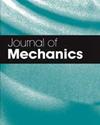调整铝表面的粗糙度,以获得超强的拒水性和吸水性
IF 1.8
4区 工程技术
Q3 MECHANICS
引用次数: 0
摘要
众所周知,超级拒水表面是通过表面粗化制成的。然而,仅仅为了不润湿和低迟滞而优化粗糙度,以促进自清洁,通常会以牺牲其他性能为代价。作为说明,这里考虑的另一个特性是对入射阳光的能量吸收。粗糙度可以调整为自清洁或替代的能量吸收,但粗糙度尺度超排斥和吸收不协调对齐。这里展示的是一种简单的制造方法,可以调整铝表面,使其具有良好的自清洁性和太阳能吸收性。我们的研究结果表明,仅微米或更小的粗糙度尺度就有利于超驱避。另一方面,几微米到几十微米的粗糙度显著改善吸收。我们对两种方法制成的表面的表征表明,调整微尺度粗糙度是如何用超拒性换取吸收率的。表面坚固,制造方法经济。太阳能热收集应用可能会受益。本文章由计算机程序翻译,如有差异,请以英文原文为准。
Tuning the roughness of aluminum surfaces for superrepellency and absorptivity
Superrepellent surfaces are known to be made by surface roughening. However, optimizing roughness solely for non-wetting and low hysteresis, which promotes self-cleaning, typically occurs at a cost to other properties. The other property, considered here as illustrative, is energy absorption from impinging sunlight. Roughness can be tuned for self-cleaning or alternatively for energy absorption, yet the roughness scales for superrepellency and absorptivity do not align cooperatively. Demonstrated here are a twin of simple fabrication methods that tune aluminum surfaces for good self-cleaning and for solar energy absorption. Our results show that superrepellency is favored by roughness scales of microns or smaller alone. On the other hand, roughness of a few microns to tens of microns significantly improves absorption. Our characterizations of surfaces made by the two methods demonstrate how tuning microscale roughness trades superrepellency for absorptivity. The surfaces are robust and the fabrication method is economical. Solar heat harvesting applications may benefit.
求助全文
通过发布文献求助,成功后即可免费获取论文全文。
去求助
来源期刊

Journal of Mechanics
物理-力学
CiteScore
3.20
自引率
11.80%
发文量
20
审稿时长
6 months
期刊介绍:
The objective of the Journal of Mechanics is to provide an international forum to foster exchange of ideas among mechanics communities in different parts of world. The Journal of Mechanics publishes original research in all fields of theoretical and applied mechanics. The Journal especially welcomes papers that are related to recent technological advances. The contributions, which may be analytical, experimental or numerical, should be of significance to the progress of mechanics. Papers which are merely illustrations of established principles and procedures will generally not be accepted. Reports that are of technical interest are published as short articles. Review articles are published only by invitation.
 求助内容:
求助内容: 应助结果提醒方式:
应助结果提醒方式:


